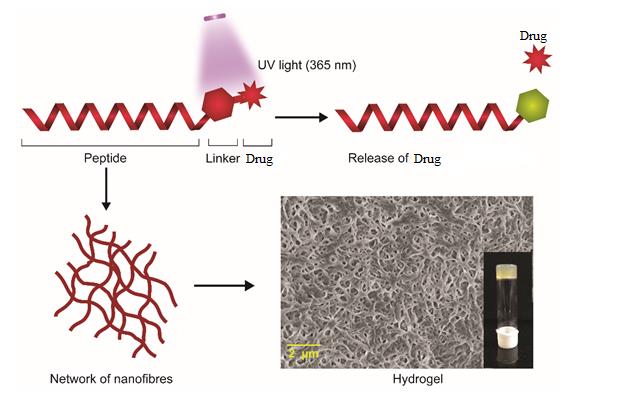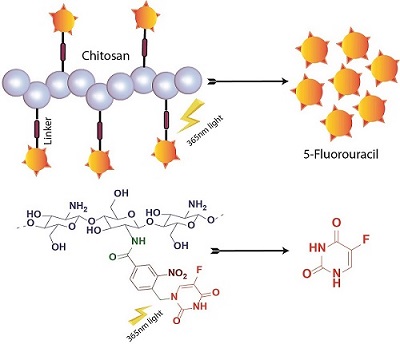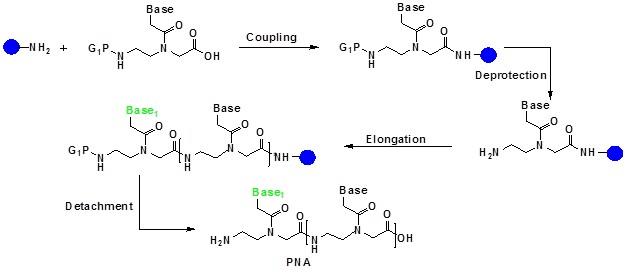
Our laboratory is engaged in synthesis of nucleobases/nucleic acids, peptides and biomacromolecules for therapeutics,
non-natural base-pairing, antitumor drug delivery, tumor cell detection, and to study various biological interactions.
Currently our research is focused on the following areas:

Cancer is one of the leading causes of deaths worldwide and according to the reports published by World Health Organization the new cases of cancer is expected to rise by about 70% over the next two decades. Most of the popular anticancer agents exhibit various side effects due to their poor selectivity towards cancer cells, uncontrolled release and various other reasons.
Hydrogels based drug delivery has found extensive application recently. In most of the cases, polymers and peptide based hydrogels were used in drug delivery. In this report, we have developed a hydrogelator containing an anti-tumor agent 5-Fluorouracil (5-Fu). The design comprised of a photo-responsive prodrug of 5-Fu covalently conjugated to an essential nutrient, biotin (vitamin B7), providing the hydrogelator high biocompatibility. The synthesized molecule formed hydrogel at pH 7. The hydrogel also can effectively entrap another water-soluble chemotherapeutic agent doxorubicin hydrochloride (DOX). The release of 5-Fu was observed in a light dependent manner whereas sustained release of DOX was recorded from the hydrogel. The controlled and sustained release of both the drugs were monitored by UV-Vis, fluorescence spectroscopy and 1H?NMR study. Such 5-Fu-biotin gel could be useful as a dual drug carrier for effective delivery of two hydrophilic antitumor agents simultaneously
The side chain of amino acid in a peptide sequence plays an important role for recognition and modification. The modification on hydrophilic side
chain of amino acid in a peptide sequence is responsible for random interaction with the nearby residue of the same peptide as well as with another peptide sequence, and hence such modified peptides can be used to deliver drug and also to design a drug. Peptides are used in a delivery system for its important features like: (i) targeted delivery, (ii) an efficient passage into cells in vivo, (iii) non-immunogenic, antigenic or inflammatory, (iv)biocompatible, being non-toxic and biodegradable, etc. We have designed some model peptides which are able to release the covalently attached small molecules in a controlled and dose-dependent manner via in-situ peptide cyclization at the physiological condition. Insertion of bent unit can break the b-sheet structure of an aggregated peptide. In this context we have designed a
series of linear peptide which can generate a kink after side chain cyclization (in-situ) in vitro to inhibit aggregation.
Accumulation and deposition of misfolded amyloid Beta peptide outside the nerve cells are one of the major causes of Alzheimer's disease (AD). To date, one of the promising therapeutic strategies for AD is to block the early steps associated with the aggregation of amyloid Beta peptide. We have developed synthetic breaker peptides derived from the original amyloid Beta sequences that undergo self-cyclization in situ. We have focussed and replaced Val-18 (of amyloid Beta) by side-chain modified glutamic acid (Glu-OBn) to generate adequate turn through in-situ peptide cyclization to disrupt the Beta-sheet structure of amyloid Beta. The disruption of amyloid fibril formation and the mechanism of the 'inhibition of aggregation' were studied by various biophysical methods, such as ThT-assay, TEM, Congo-red birefringence study. CD and FTIR spectroscopy were used to characterize the conformational change during the aggregation process. Results suggest that designed breaker peptide s may be useful to inhibit and disrupt not only amyloid Beta peptide but related peptides that undergo aggregation..

We also work on synthesis of biopolymeric nanomaterials based drug delivery systems for controlled and targeted delivery of antitumor drug.
The polymeric nanomaterials are prepared using chitosan, silk fibroin etc. For controlled drug delivery, we design stimuli responsive polymer-drug conjugates nanoparticles and for
targeting the cancer cells, various targeting moieties are attached to the
developed systems.
Chemically modified biopolymers derived nanomaterials have shown great potential in drug delivery and live-cell imaging. We have developed two materials, doxorubicin-loaded chitosan-gold nanoparticles and beads, both embedded with functionalized silk fibroin. Nanoparticles with size 5-11 nm were synthesized using chitosan as reducing and stabilizing agent. Beads with 900 to 1000 micro meter size were formulated by the ionic gelation technique. Both the materials were coated with functionalized silk fibroin for targeted and sustained drug release properties. The coated materials showed retarded drug release compared to the uncoated ones. The cytotoxicity was assessed in HeLa cell lines, which demonstrated a maximum dose-dependent decrease in cell viability for the cells treated with folate conjugated silk fibroin coated nanoparticles. The live-cell imaging of the nanoparticles unveiled the increased cellular uptake of the coated materials by seven folds than the uncoated ones. Thus, functionalized SF coated materials can be effective drug delivery tools for targeted and sustained drug release..

